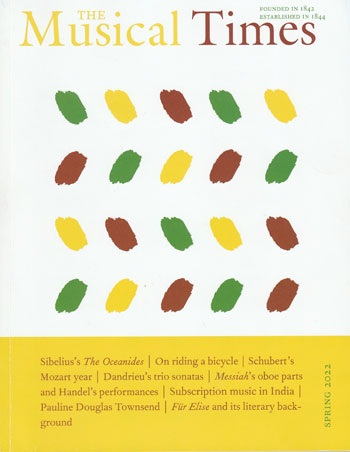
BBC Music

What’s it about: ‘The world’s best-selling classical music magazine’ – telling it how it is under the masthead.
Vital statistics: March 2022 issue: 108 pages of 277mm x 215mm. Gloss paper, heavyweight cover, perfect bound. £6.50 cover price. Latest ABC circulation of 26,186 (Jan-Dec 2021). Published monthly by Our Media Ltd (an Immediate Group Company) in Bristol, under licence from BBC Studios.
Cover: Big picture of ‘A man for all seasons’, the tenor Nicky Spence, six other coverlines, including a small picture, elegant masthead and a shot of the Beethoven CD that is glued in the corner.
Content: Editor’s ‘Welcome’ on page three before two illustrated pages of contents, including a healthy nod to the reviews section. ‘The full score’ is a newsy start before the covers story, which runs to six pages. A fascinating round-up of train-related compositions – think of the Auden-Britten collaboration, Night Mail – and ‘A Walk with Holst’ are features that could grace any mainstream sophisticated publication. A spread of letters, 15 musical nonagenarians, full monthly listings to Radio 3 and those reviews offer a change of pace amongst the more weighty features.
Digital: Have snagged the go-to url of classical-music.com that has news and reviews plus opportunities to watch and listen. Links to 28.7k likes on Facebook, 68.8k followers on Twitter plus Instagram and YouTube.
What they say: “I couldn’t ask for a more interesting and varied first issue as editor of BBC Music Magazine, as I hope you’ll agree!” – big sigh of relief in her ‘Welcome’ piece from editor Charlotte Smith, who took over in January after four years as editor of The Strad.
Verdict: Another cracking collaboration between the BBC and Immediate – Good Food, History, Wildlife also in that club – which combines the wealth of content that the broadcaster can provide with the editorial nous of the publisher. Looks good too, plus the covermount CD which can only add value.
Choir & Organ

What’s it about: ‘Two worlds of music, one magazine’ – strapline under masthead.
Vital statistics: March 2022 issue: 84 pages of 278mm x 216mm. Quality matt paper, heavyweight gloss cover, perfect bound. £6.50 cover price. Published 10 times a year by MA Music, Leisure & Travel Ltd from a renovated old church between Brixton and Dulwich in south east London.
Cover: Big picture of man seated at the organ with attendant coverline, three other coverlines, promos to two offers and a delightful illustration to go with a Lisbon travel piece.
Content: All the contents are trailed on page five, along with minipoint who’s who and what’s what. A creditable 10 pages of news, followed by the cover story containing tributes to Dr Francis Jackson. Other features include the ins and outs of an organ in Berlin, which has a magnificent full-page picture, a new choral work prompted by the killing of George Floyd, two brothers who have more than 46 million views on YouTube and a Q&A with a conductor. Also finding a home are download and print ‘a free score’ (that’s music, by the way), a page of readers’ offers, ‘Travellers Joy’ in Lisbon, and a wodge of reviews.
Digital: Promo on the cover and folio lines to choirandorgan.com, a lively website with lots of background info plus news, features and a comprehensive listings. Hunt around to find Twitter, with 3.5k followers, and 2.3k likes on Facebook.
What they say: “He is passionate about singing and is a keen tenor as well as an enthusiastic pianist who can negotiate most (though by no means all) of the notes” – editorial director Ashutosh Khandekar covers some of the bases on the corporate website.
Verdict: Confidently straddling the two ‘worlds’ of its title, this engaging magazine is a lively read, with assured writing, clean design and enough variety to keep everyone happy.
Opera

What’s it about: ‘The world’s leading opera magazine’ – incorporated in the digital masthead.
Vital statistics: March 2022 issue: 130 pages of 210mm x 147mm. Matt paper, heavyweight gloss cover, perfect bound. £6.50 cover price. States readership of 30,000 in the rate card. Published monthly by Opera Magazine Ltd in West London.
Cover: Enchanting picture of a ballerina and a bear, from Rimsky-Korsakov’s Christmas Eve we learn, plus nine coverlines and the clean masthead expertly displayed on the limited tableau.
Content: Straightforward contents on what would be page 3, if it wasn’t page 257, followed by the editor having his say and, maybe surprisingly, ‘Newsdesk’ which kicks off with a topical story about Covid cancellations. The major features centring around ‘Dance in Opera’ are well illustrated. Five pages of obituaries, ‘Opera around the World’ is just that, while ‘Opera in the UK’ has five in-depth reviews, CDs, DVDs, books, coming events and a detailed calendar.
Digital: Website at the best url possible – opera.co.uk – has some in-depth features and opportunities to subscribe. Links to Facebook with 3.8k likes, Twitter with a very creditable 42.8k followers and Instagram. Also get a free sample and sign up to the newsletter.
What they say: “Obviously, I am going to be a very big fan of any magazine so in love with opera, and I am proud to say that I have read Opera magazine for many years. This small and beautiful magazine is one of the true authorities of the opera world” – the late Luciano Pavarotti adds his endorsement from the upstairs opera house on the rate card.
Verdict: Quality advertising including Steinway pianos, a singing competition with €70,000 in prizes and performances in Santa Fe and Sweden amply confirm the credentials of this dedicated publication. The natty size – remember the Glamour handbag-sized from the 00s? – adds a distinctiveness to this crowded genre.
Pianist

What’s it about: ‘Helping you become a better player’ – nestling in the masthead.
Vital statistics: February-March 2022 issue: 84 pages of 295mm x 210mm. Matt paper with heavyweight ‘The Scores’ section, gloss cover, stitched. £5.99 cover price. States a magazine “reach of 13,000” in the media pack. Published six times a year by Warners Group Publications in Bourne, Lincolnshire.
Cover: Big picture of pianist Javier Perianes gazing wistfully while leaning on a piano, to head up ‘Viva España’. Eight assorted coverlines, including ‘Free audio CD’ which is glued to the bottom left corner.
Content: A straightforward display of contents on page three followed by the editor’s musings and letters before the cover story, complete with Zoom interview. ‘How to Play masterclasses’, ‘Piano teacher help desk’, more Spanish themed revelations and book and album reviews surround the gift of love that is ‘The Scores’. Forty-eight pages of sheet music for all the tracks on the cover-mount CD, including some household favourites like Bizet and Debussy as well as less well-known composers to fit the Spanish theme.
Digital: Clean and tidy website at pianistmagazine.com with links to Facebook with 19.1k likes, 14.4k followers on Twitter, a YouTube channel with an amazing 88k subscribers watching the ivories being tickled.
What they say: “Almost 20 years into the job and what’s the first thing I still think about when I wake up? DEADLINES! How many weeks, days, hours, minutes until we go to press?” – editor Erica Worth shares the pain of the hot-seat with readers in A Day in the Life Of…
Verdict: The CD and sheet music alone are worth the entry price to this homage to all things piano. The words and pictures trip along allegro, helped by plenty of illustrative notations and up-for-it design. A good mix of advertising, including a £150,000 piano on the back page, gives a rounded feel.
The Musical Times

What’s it about: ‘Founded in 1842 and established in 1844, The Musical Times is the world's oldest English-language classical music journal’ – explainer on the website.
Vital statistics: Spring 2022 issue: 124 pages of 247mm x 190mm. Matt paper, gloss card cover, perfect bound. Yearly subscription: £48 for four issues, although institutions pay double. Circulation figures “not publicly available”. Published quarterly by The Musical Times Publications Ltd in Aston Clinton, near Aylesbury.
Cover: Twenty colourful blobs on a white background. Eight cross-refs to content inside and the sophisticated masthead. Spine has room to explain this is Vol. 163 No. 1958.
Content: List of contents on first inside right-hand page (numbered 1) followed by mini-biogs of the contributors. Dense academic treatises broken up by musical notations. Exacting examinations of individual composers (Schubert, Sibelius, Beethoven etc), the more enigmatic ‘On riding a bicycle’, a piece on publishing music by subscription in India (1789-1811) and a review of a £120 book about Stravinsky. Incorporating copious footnotes and tables plus one picture of a not-quite Mrs Beethoven and some other 18th century illustrative reproductions.
Digital: Plenty of promos to digital on pages 1 and 2 leading to a blog-style website at themusicaltimes.blogspot.com. A full index going back to 2008 plus an opportunity to buy past copies and inspect the current issue via Exact Editions. No social media, although a US publication also called ‘The Musical Times’ is there to muddy the waters.
What they say: “With its slow-cooked articles and book reviews designed to nourish souls famished by the fast food of musical journalese and the indigestible gristle of the ‘research paper’, The Musical Times – scholarly yet accessible – really needs no introduction.” – An, er, introduction at Exact Editions.
Verdict: Beautifully put together with a very clean and clever design, this academic journal has straddled the more populist market. No advertising so a clear run at music, music, music and then more music.
The Strad

What’s it about: ‘Voice of the string music world since 1890’ – descriptor on Twitter.
Vital statistics: April 2022 issue: 96 pages of 295mm x 215mm. Gloss paper, heavyweight cover, perfect bound. £5.95 cover price. “Reaches an audience” of 39,000, according to the media pack. Published monthly by Newsquest in London.
Cover: Big picture of man with cello, complemented by main coverline identifying him as Johannes Moser. Five other cross-refs and a delightfully arty masthead, with ‘the’ in red, providing the only striking colour on the page.
Content: Push past the early ads to find contents spread on page four, taking in features, regulars, music and lutherie – the craft of making stringed musical instruments, says Mr Google – among the promises. News comes via ‘On the beat’ before ‘Life lessons’ from an American violinist and the lavishly illustrated cover story. An annotated view inside a workshop is a delight while ‘Teaching & Playing masterclass’ has musical scores to follow. Reviews take in concerts, recordings and books while an advertisers’ index is just that.
Digital: A full-service website at thestrad.com has plenty to read, look at and listen to while ‘premium subscriber content’ is a welcome addition for those who pay. Links to lively social media feeds with 22.9k followers on Twitter, 82.4k likes on Facebook and 27.6k followers on Instagram.
What they say: “You ask me to send a message to the readers of The Strad. Well, I hardly know what to say. I have read the little paper with interest for a long time, and feel as though I had many friends amongst Strad-ites” – Czech violinist and influential teacher, Otakar Šev?ík, asked to pass on words on wisdom… in February 1912.
Verdict: Exquisitely designed with beautiful cut-outs of instruments throughout. The content is both varied and completely on-message for anyone who wants to hear the “Voice of the string music world”. Oh, and check out the free seven-day subscription to try before you buy.
This article was first published in InPublishing magazine. If you would like to be added to the free mailing list, please register here.










